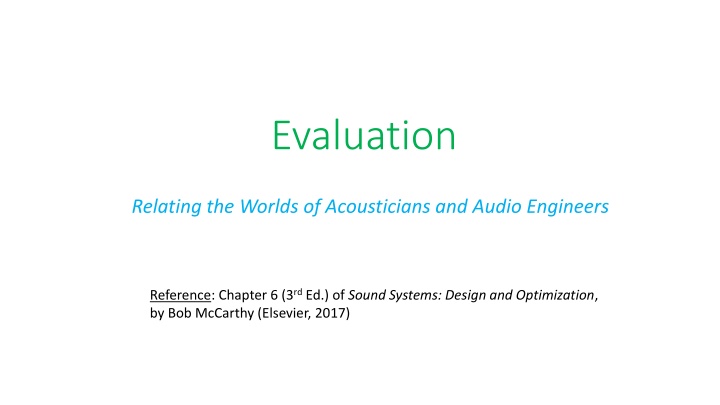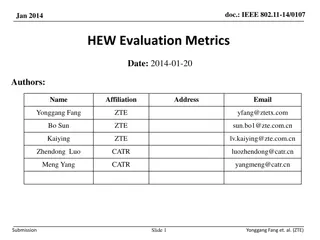
Exploring Acousticians and Audio Engineers: A Comparative Analysis
Delve into the worlds of acousticians and audio engineers with a detailed comparison covering natural vs. amplified sound, room parameters, and reception characteristics. Discover the distinctive features of both natural and amplified emission, transmission, and reception in the realm of audio design and optimization.
Download Presentation

Please find below an Image/Link to download the presentation.
The content on the website is provided AS IS for your information and personal use only. It may not be sold, licensed, or shared on other websites without obtaining consent from the author. If you encounter any issues during the download, it is possible that the publisher has removed the file from their server.
You are allowed to download the files provided on this website for personal or commercial use, subject to the condition that they are used lawfully. All files are the property of their respective owners.
The content on the website is provided AS IS for your information and personal use only. It may not be sold, licensed, or shared on other websites without obtaining consent from the author.
E N D
Presentation Transcript
Evaluation Relating the Worlds of Acousticians and Audio Engineers Reference: Chapter 6 (3rd Ed.) of Sound Systems: Design and Optimization, by Bob McCarthy (Elsevier, 2017)
Outline Natural vs. amplified transmission paths Subjective room parameters Natural sound vs. amplified sound Common goals
Features of Natural Emission/Transmission/Reception Individual sources are mixed on stage Emission originates from multiple sources in one general location (the stage) Transmission support by the room is required Separation between the emission sources and the transmission medium is prohibited (musician, stage, and house are all one) Reception becomes uniform in level and tone by lack of separation
Features of Amplified Emission/Transmission/Reception Individual emission sources are isolated on stage, and the stage is isolated from the main transmission system Transmission originates from multiple locations (stage, stage monitors, house main speakers, house auxiliary speakers) Transmission support by the room is an optional enhancement, not a requirement Separation between the emission and transmission sources is required (musician, stage, and house are all separate) Reception becomes uniform in level and tone by virtue of separation
Subjective Room Parameters intimacy feeling of proximity to the music (as if listening in a small room) liveness fullness of tone in mid/high range warmth fullness of tone in low frequencies loudness of direct sound appropriately scaled to musical content loudness of reverberant sound appropriate mix of level and duration definition, clarity clear and distinct sound brilliance bright, clear, rich in harmonics diffusion spatial aspect of reverberation (sound arriving from all directions)
Subjective Room Parameters balance relative level of instruments and voice (instruments heard in proper level perspective) example: lute and bagpipe duet PDQ Bach, Sinfonia Concertante S. 98.6 blend harmonious mix of instruments ensemble how well musicians can hear themselves immediacy of response measure of how well the musicians feel about the responsiveness of the sound texture the fine grain of the listening experience (fine texture = richness and complexity in its outer surface )
Subjective Room Parameters freedom from echo discrete echoes are not heard freedom from noise the noise floor of room/system is low dynamic range difference between maximum level and noise floor tonal quality flat system response uniformity the extent to which all listeners have the same experience
Room Design to Support Natural Acoustics vs. Amplified Sound
Natural vs. Amplified: Diffusion Reflections provide a richer reverberation character if the surfaces are diffuse; scattering provides a more gradual and dense reverberation tail Natural: summation arrivals become more randomized, leading to more texture, a steady decay character, and less risk of echo perception Amplified: summation arrivals become more randomized, leading to more texture, a steady decay character, and less risk of echo perception
Natural vs. Amplified: Freedom From Echo Achieved by preventing single reflections to stand out above the decay pattern or focus points to occur from the confluence of multiple reflections Natural: reflections must transition steadily toward isolation Amplified: greater risk because of lower reflection density and higher sound levels; concentrated beams of directional speakers increase possibility of focused reflections ( slap back from rear wall or balcony surface)
Natural vs. Amplified: Freedom From Noise Natural: achieved by isolating the transmission from noise sources Amplified: same as natural, with addition of electronic noise and feedback/ ringing (also, filtering out excessive sibilance also called de-essing) Reference: https://www.youtube.com/watch?v=k9exwW0fpw8
Natural vs. Amplified: Intimacy Initial time delay gap: early arrivals should be within 5 dB and 20 ms offset of direct sound Natural: strong reflective summations are needed for acoustic power addition; multiple arrivals required to provide sufficient comb filter density (so that dips/peaks are beyond tonal resolution of ear) Amplified: strong reflective summations are NOT needed for acoustic power addition; since speaker is single directional source the reflection pattern lacks complexity, and the combing summation will be perceived as a tonal distraction!
Natural vs. Amplified: Liveness Optimum reverb time is program-material dependent Natural: reverberation is highly dense combining zone and isolation zone summation; the density neutralizes the tonal signature and provides a desirable sense of spaciousness Amplified: separation of room into distinct speaker coverage areas breaks the unifying element of room reverberation, rendering it less uniform; best when meets minimum needs and principally provides spatial enhancement (bulk supplied electronically discuss good and bad ways of doing this)
Natural vs. Amplified: Warmth Achieved by ensuring reverberation time in low frequencies about 25% longer than that of midrange/highs Natural: reflective surfaces should be of sufficient density and hardness to reflect low frequencies and ensure sufficient LF reverb time (plaster, thick wood) Amplified: coupled speaker/subwoofer arrays and nearby surfaces provide conditions for uniform LF summation; sufficient LF power capability obviates need for longer LF reverb time
Natural vs. Amplified: Loudness of Reverberant Sound Natural: must scale with venue size; achieved with strong, extremely dense combing zone, combining zone, and isolation zone summation Amplified: ratio of direct to reverberant sound should be kept as high as possible achieved by minimal combing and combining zone summation (isolation zone summation accepted within limits for its ability to provide sense of spaciousness)
Natural vs. Amplified: Ensemble Natural: strong/dense combing, combining, and isolation zone summation sound of each instrument must spread across stage to other musicians; instruments not isolated from one another Amplified: ensemble on stage achieved by isolating the individual sound sources, combining electronically in the mixer, and returning the signal via individually adjustable stage monitors (problems: stage monitors near microphones can re-enter transmission path, causing combing/feedback; also, disturb acoustic partitioning of house speakers solution: use in-ear monitoring?)
Natural vs. Amplified: Definition/Clarity Achieved by optimal mix of intimacy, liveness, and loudness Natural: mix of direct sound, dense combining zone, and isolation zone summation is required Amplified: clarity is result of a high ratio of coupling and isolation zone summation, and a low ratio of combing zone achieved by directional speakers with distinct coverage zones and carefully managed patterns
Natural vs. Amplified: Response/Attack Natural: stage is directly coupled to house; how transmission character of house returns to stage is decisive factor (reverb time) Amplified: monitors are principal reference on stage, yet sound in house will have an appreciable effect on experience (loudspeaker sidelobes and rear-wall or balcony face reflections) may need to compromise on isolation from main transmission system trying to achieve through use of monitors
Natural vs. Amplified: Tonal Distortion Prevented by not allowing absorption to occur at selected frequency ranges Natural: prevented by dense complex multiple summations of different relative time and level (if a single reflection is too dominant it will cause cancellations and excessive additions) Amplified: minimized by focusing on coupling zone and isolation zone summations (combing zone is avoided to maximum extent possible); tonal distortions unique to amplified systems include harmonic distortion, dynamic range compression, sonic image distortion, and excessive sibilence
Natural vs. Amplified: Uniformity Hall is free of dead spots and/or response anomalies (maximum similarity of sonic experience) Natural: achieved by coupling all seating areas to transmission system, and saturating the frequency response with super dense combing, combining, and isolation zone summations Amplified: achieved by isolating the speakers from each other and the room; frequency response is maintained by coupling and isolation zone summations (combing zone avoided to the extent possible)
Natural vs. Amplified: Loudness of Direct Sound Natural: maintained by arranging seating as close to conductor as possible (benchmark is 60 feet) function of transmission path length from stage to listener Amplified: function of transmission path length, drive level of speaker, and axial orientation; directional speakers in separate locations allow constant level to be maintained over space
Natural vs. Amplified: Brilliance Achieved when sound is intimate and reverb time in HF balanced with midrange Natural: mix of direct sound, dense combing zone, and isolation zone summation is required Amplified: distant speakers will have HF boost to compensate for HF air loss ( pink shift ) separated directional speakers allow for even amounts of HF distribution
Natural vs. Amplified: Balance Natural: the room must transmit all instruments in the proper mix; stage and house reflections must have sufficient strength and density for uniform level and frequency response to be achieved balancing of instruments is in the acoustic space Amplified: role of speaker system is transmission of pre-mixed signals originating at mix console stage sources are isolated and balanced in the mix electronically
Natural vs. Amplified: Blend Natural: harmonious blend achieved by positioning of instruments spacing between instruments on stage is a key factor Amplified: role of speaker system is transmission of pre-mixed signals originating at mix console instruments are blended by separation into multiple transmission channels (left, right, center) and appropriate use of panning; isolated electrical signals are blended in the acoustic space
Natural vs. Amplified: Texture Achieved by carefully spaced and sequenced reflection patterns Natural: achieved by a steady transition of the low level reflections through the isolation zone (enhanced by high reflection density) Amplified: acoustic texture can be augmented electronically with the isolation zone summation induced by outboard reverberation (and can be applied separately to different input channels)
Natural vs. Amplified: Dynamic Range Maximized by having the strongest summation of the direct sound and early reflections while keeping background noise to a minimum Natural: maximum acoustic addition requires both coupling and combing zone summation Amplified: maximum acoustic addition requires both coupling and combining zone summation; limited by power handling capability of system and gain before feedback
Common Goals tonal balance freedom from potentially disturbing reflections uniformity of diffuse energy (e.g., under-balcony) appropriate (low) levels of ambient noise uniformity of sound field clarity and intelligibility
Amplified-Speaker-Centric View room shape line of sound considerations matching shape to purpose stereo everywhere difficult in wide spaces under-balcony spaces height must increase as depth increases side seating areas challenging! low-frequency absorption/diffusion, bass traps tight low end mid-frequency diffusion areas near speakers, or on-axis
Amplified-Speaker-Centric View high-frequency absorption/diffusion especially needed on rear walls ceilings want to avoid them (preferably splay away from speaker locations) sidewalls benefit from outward splay angle floor/seating/aisle areas treat with carpeting as needed hidden speaker locations must be acoustically transparent main speaker locations try to keep image low/central
Amplified-Speaker-Centric View front fill speakers locations keep as high as possible mix position needs to be in the house stage benefit from variable acoustics (e.g., moveable drapes) surface complexity aids diffusion balcony fronts usually benefit from absorption
Middle Ground variable acoustics (reverberation control) curtains rotating wall panels acoustic filters electronic reverberation enhancement optimum is to have separate (distributed) reverberation source loudspeakers (vs. running through main system)






















